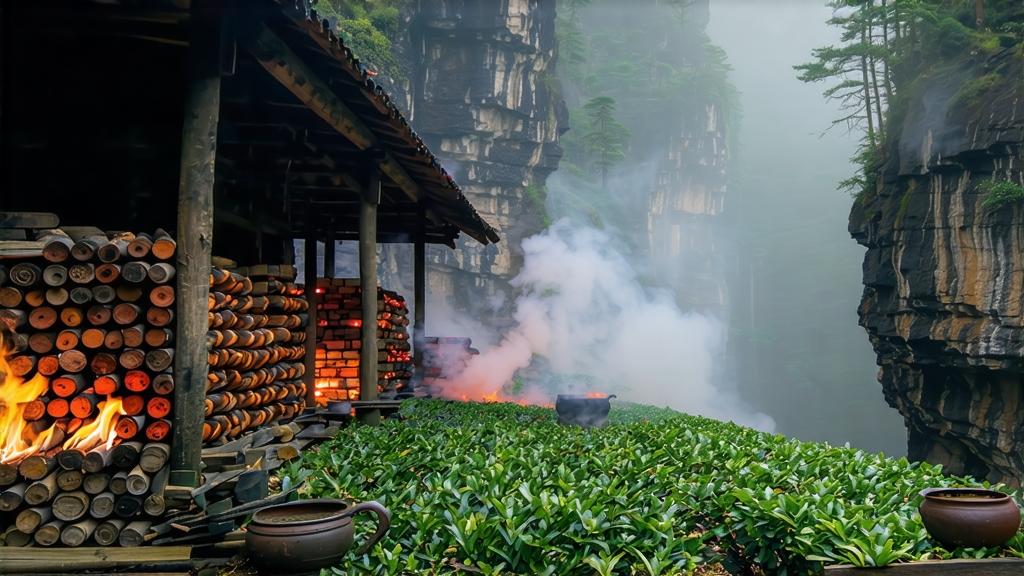
Long before the English added milk and sugar to their “bohea,” before tea clippers raced across oceans, and before Assam or Ceylon were even planted, a small village in the Wuyi range of northern Fujian produced the very first fully oxidised leaf the world would come to call “black tea.” That village is Tongmu, and the tea is Lapsang Souchong—an assertive, pine-smoked ancestor whose story is etched into every wiry, tar-black strand. To understand Lapsang Souchong is to understand how China taught the globe to drink tea beyond green, and how one rugged landscape could flavour commerce, poetry, and daily ritual for four centuries.
History: From Ming-Era Accident to London’s Breakfast Cup
Local legend claims the style was born around 1568 when a Ming army unit bivouacked in Tongmu forced villagers to abandon their fresh leaf. To save the harvest, farmers rushed the withering and drying over open pinewood fires; the resulting smoky leaf fetched extravagant prices from passing Dutch traders. By 1604 the first chests reached Amsterdam, and within decades the British East India Company had rebranded it “Bohea” (from the Min-dialect pronunciation of Wuyi). When Catherine of Braganza served it to Charles II, smoky lapsang entered court fashion; by the eighteenth century it underpinned the Boston Tea Party chests and fueled London coffee-house debate. Thus, a Chinese mountain accident became the prototype for every subsequent black tea.
Terroir: Why Only Tongmu Can Be “Original”
The Wuyi range is a UNESCO geopark of vertical cliffs, mineral-rich igneous rock, and a micro-climate trapped by perpetual mist. Day-night temperature swings of 15 °C slow leaf growth, concentrating sugars, amino acids, and volcanic minerality. Crucially, the village sits inside a national nature reserve; every kilo of authentic Zheng Shan (“Original Mountain”) Lapsang must be picked within the 600–1,200 m contour and processed inside the 52 km² core zone. Outside this perimeter, even identical cultivars and smoke yield flatter liquor lacking the signature lychee-sweet finish.
Cultivars: Beyond the Generic “Souchong”
Although international markets often treat “Lapsang” as a monolith, Tongmu artisans work with at least four clonal bushes:
- Cai Cha – the old seed-grown landrace, small leaf, high aromatics, traditional pine partner.
- Xiao Ye Zhong – “small-leaf species,” picked earlier, giving a brighter, citrus-smoke note.
- Jin Guan Yin – a Wuyi rock-oolong cultivar grafted onto Bohea rootstock; yields a cocoa-sweet, barely smoked “unsmoked lapsang” popular in eastern China.
- Mi Lan Xiang – honey-orchid fragrance cultivar reserved for premium lots, smoked only with aged fir to preserve its natural florals.
Pluck Standard: One Bud, Two Leaves, Zero Pesticides
Because the reserve bans agro-chemicals, farmers still hand-pick the tender “zhong kai mian” standard—literally “when the middle leaf unfolds like a noodle.” Picking occurs only between Qingming and Grain Rain (early April to early May) when polyphenol ratios hover at 22–25 %, ideal for full oxidation without excessive astringency.
Craft: The Eight Stages That Trap Smoke Inside the Leaf
- Outdoor Withering: Fresh leaf is laid on bamboo mats in the shade of the village’s camphor and masson pines for 4–6 h, reducing moisture to 65 %.
- Indoor Withering: Moved to the upper loft of the three-storey wooden tea house, where pinewood embers in ground-level hearths send warm air upward; another 6–8 h brings leaf to 45 % moisture while infusing a preliminary resinous note.
- Rolling: A 45-min gentle roll on cast-iron trays bruises cells without breaking veins; oxidation enzymes are released while leaf remains intact for later smoke absorption.
- Oxidation: Rolled leaf is stacked in rattan baskets inside a humid 24 °C room. Oxidation proceeds for 3–5 h until leaf turns copper-red and the green “grassiness” disappears.
- Pan-firing: Quick 220 °C stir-f